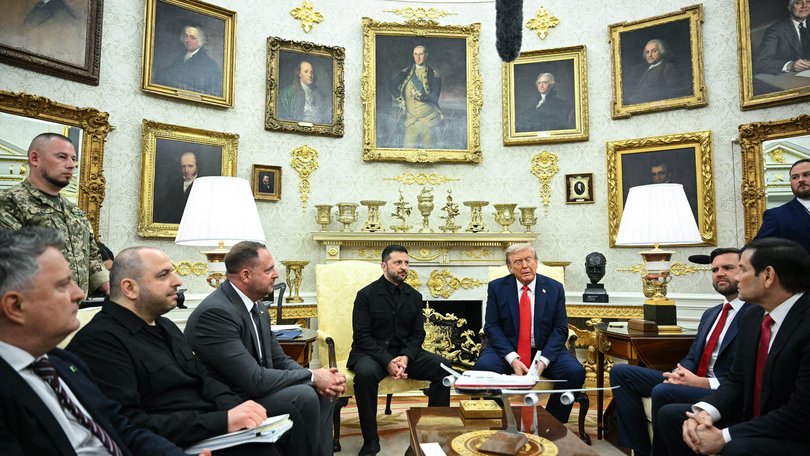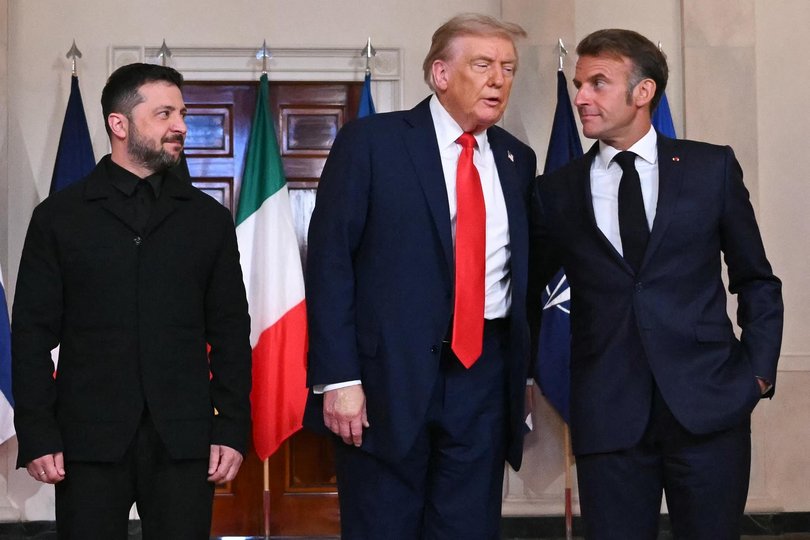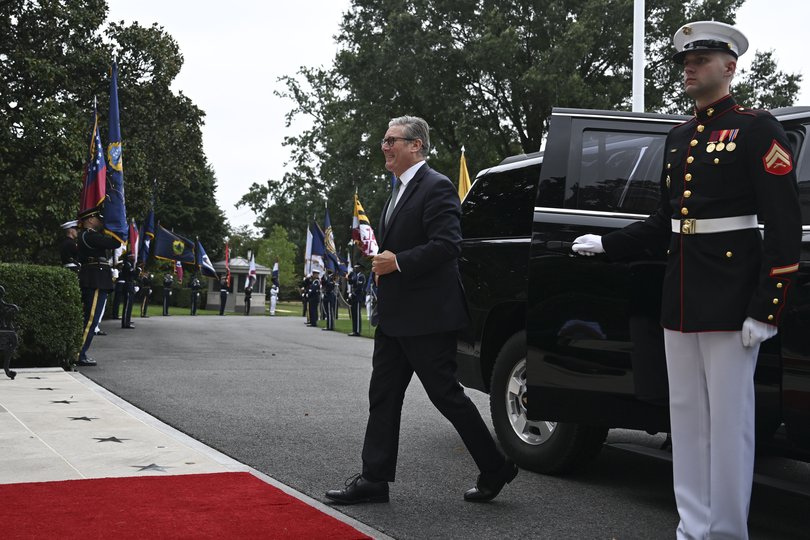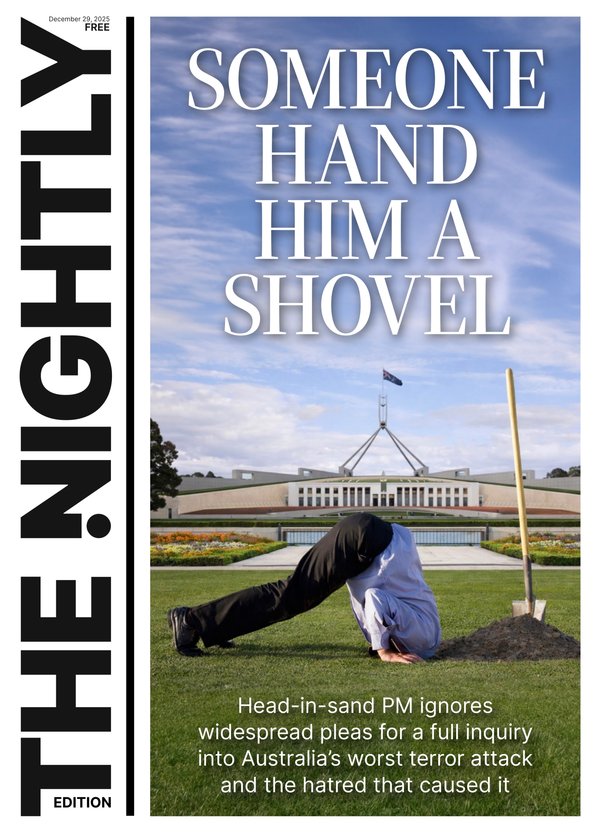THE WASHINGTON POST: In hurried DC summit, Europeans try to bend Trump away from Kremlin

Leaders of European and NATO countries presented a united front Monday with Ukrainian President Volodymyr Zelensky, after racing to Washington hoping to steer President Donald Trump away from some of the concessions he appeared ready to grant the Kremlin to end the war in Ukraine.
Mr Trump offered a polite reception to Mr Zelensky, a stark difference from his visit in February, when he was ejected from the White House after a meeting turned into a verbal attack by Mr Trump.
The welcome fell short, however, of the red carpet and B-2 bomber flyover that greeted Russian President Vladimir Putin when he arrived Friday to meet Mr Trump in Anchorage.
Sign up to The Nightly's newsletters.
Get the first look at the digital newspaper, curated daily stories and breaking headlines delivered to your inbox.
By continuing you agree to our Terms and Privacy Policy.After several hours of meetings, sharp differences remained evident between the European leaders and Mr Trump, who declared that Mr Putin is ready for peace, even as he has continued his bombardment of Ukraine and demanded sweeping, painful concessions to stop the war.
The discussions remained fluid as Mr Trump vowed to seek a joint meeting with Mr Zelensky and Mr Putin as quickly as possible. There was no immediate move toward the ceasefire that Ukraine has pressed for, and Europeans were seeking more detail about potential promises from Washington to help underwrite Kyiv’s security. Mr Putin has also demanded that Ukraine hand over strategically important territory as part of a deal.

Monday’s unusual group meeting at the White House continued an extraordinary sequence of diplomacy that could shape security in Europe for a generation, with European leaders fearing that Mr Putin was getting the upper hand in a breakneck peace effort. Mr Trump revelled at Monday’s tableau, saying that the White House had never seen such a collection of prime ministers and presidents, all of whom dropped what they were doing to rush to Washington to try to salvage Ukraine’s security.
Several of the leaders, including French President Emmanuel Macron and German Chancellor Friedrich Merz, tried to frame their goals as Mr Trump’s own, portraying an immediate ceasefire and robust US security guarantees for Ukraine as ideas endorsed by the White House. Mr Trump, however, appeared to reject a ceasefire and remained vague about what he would offer Ukraine to bolster its defence as part of any deal. Instead, he portrayed Mr Putin as someone who is eager to halt the fighting.
“I don’t think there’s any issue that’s overly complex. It’s at a point now where people want to do things, I really do believe,” Mr Trump said alongside European leaders in the East Room of the White House. “I’ve known (Mr Putin) for a long time. I’ve always had a great relationship with him. I think that President Putin wants to find an answer too.”
Mr Trump at one point paused the East Room meeting and left the European leaders to speak by phone to Mr Putin, according to one person familiar with the talks, who spoke on the condition of anonymity to talk frankly about the sensitive closed-door conversations. It wasn’t immediately clear why the meeting was interrupted after Mr Trump initially said he would call Mr Putin after he was done with the Europeans.
The President gave no indication he was prepared to push for an immediate ceasefire, a top Ukrainian priority, instead granting Mr Putin the ability to maintain pressure on Kyiv.
Mr Macron and Mr Merz pressured Mr Trump to demand a ceasefire ahead of the possible joint meeting with Mr Zelensky and Mr Putin. Mr Macron sought to position such a move as Mr Trump’s idea, even after the President signalled he was willing to allow the war to continue during negotiations.
“In order to organize such a trilateral meeting, your idea to ask for a truce or ceasefire, at least to stop the killings, as we discussed, is a necessity,” Mr Macron said. “And we all support this idea.”
But Mr Trump claimed no ceasefire was needed to negotiate the ends of other conflicts during his presidency.
“All of us would obviously prefer an immediate ceasefire while we work on their lasting peace,” Mr Trump said with the world leaders. “And maybe something like that could happen. As of this moment, it’s not happening.”
A military colour guard holding US state flags flanked the driveway to the White House as Mr Zelensky arrived in a black SUV, with small Ukrainian and American flags waving from the fenders.
Mr Trump raised his fist as Mr Zelensky’s car pulled up to the West Wing lobby entrance, then gave him a warm handshake and put his arm around his shoulders before ushering him into the White House.
Mr Trump said he complimented Mr Zelensky’s black jacket and collared shirt - a departure from the military-style fatigues that were mocked during the Ukrainian president’s disastrous February visit to the White House.
Mr Zelensky appeared to learn from that meeting and adopted the playbook that has helped other European leaders succeed with Mr Trump: flattery.
“I think that we had very good conversation with President Trump. … it really was, the best one,” Mr Zelensky said after his one-on-one meeting with Mr Trump. “Or, sorry, maybe the best one will be in the future. But it was really good.”
He also handed the president who loves letters a handwritten note from his wife for first lady Melania Trump, thanking her for her letter to Mr Putin about the plight of children in Ukraine.
Mr Zelensky remained cordial in the opening remarks of the Oval Office meeting, even as Mr Trump appeared to concede to some of Mr Putin’s demands. Mr Trump claimed that “strategically” a ceasefire “could be a disadvantage for one side or the other,” as Ukraine and European leaders seek an immediate halt to the fighting. The main beneficiary of a ceasefire would be Ukrainian civilians, who would be spared after more than three years of attacks.
Without a ceasefire, Russia has continued to pound Ukraine, killing at least two children in overnight attacks in Kharkiv and Zaporizhzhia. Mr Zelensky said in the Oval Office that one of the victims was under the age of 2.
Mr Merz pressed Mr Trump to secure a ceasefire, saying that he “can’t imagine” the next meeting could occur without one.
“And let’s try to put pressure on Russia, because the credibility of this effort, these efforts we are undertaking today are depending on at least a ceasefire from the beginning of the serious negotiations from next step,” Mr Merz said.
Mr Trump said that the United States would be “involved” in keeping peace in Ukraine after any peace agreement with Russia, but offered few specifics on the role that US forces would play.

“The European nations are going to take a lot of the burden,” Mr Trump said in a meeting with Mr Zelensky and the other leaders. “We’re going to help them, and we’re going to make it very secure.”
As Mr Trump, Vice President JD Vance and other top administration officials met with Mr Zelensky in the Oval Office, the leaders of NATO, Britain, Germany, France, Italy, Finland and the European Union all were left to wait for their turn with Mr Trump, after having been asked to arrive at the South Portico shortly before Mr Zelensky.
Ahead of the meetings, Mr Trump suggested a deal is possible.
“Not very far from now, a week or two weeks, we’re going to know whether or not we’re going to solve this or is this horrible fighting going to continue. We’ll do the best to get it ended,” Mr Trump said. “And I believe we have two willing parties, and usually that’s good news.”
European leaders have welcomed Mr Trump’s new openness to possible US security guarantees for Ukraine, which he offered in general terms while briefing them by phone after Friday’s meeting with Mr Putin. Ukraine’s European allies have long sought such a US role. But several officials familiar with the talks said specifics on those guarantees remained unclear in phone calls with Mr Trump.
European officials insist that guarantees are key to any settlement to give Kyiv protection against future attacks and a means for Mr Zelensky to get domestic acceptance for a deal with Russia.
A coalition led by France and Britain has for months planned ways to back Ukraine in a future deal, including with weapons and possibly some troops. France and Britain, Europe’s only nuclear powers, are the only countries that have announced readiness to deploy troops. As other big nations, such as Germany, hesitate, ideas on the size of such a force were whittled down.
Beyond troops, however, plans include providing air and sea power to secure Ukraine’s skies, nuclear sites and Black Sea corridors, and above all, reinforcing Ukraine’s army with pledges of weapons and training.
France and Britain had sought US support for a deployment of a small group of forces to postwar Ukraine, away from the front lines. The proposals draw on US backing with key capabilities such as intelligence and satellite surveillance and would aim to deter Russia from attempting to reignite the war.
Italian Prime Minister Giorgia Meloni said ahead of Monday’s meeting that the weekend call with Trump offered a “glimmer of hope” and included “credible and robust” security guarantees, touching on the idea of guarantees similar to NATO’s Article 5 on collective mutual defence - that an attack on one is an attack on all.
It remains unclear how this would work and what exact role Washington would play, officials said. The idea of security guarantees has faced some scepticism from other European officials, who note that promises of coming to Ukraine’s defence if it is attacked have been made in the past but did not bring protection.
